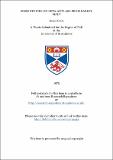Files in this item
Some studies on β-amylase from barley malt
Item metadata
| dc.contributor.advisor | Ledingham, W. M. | |
| dc.contributor.author | Cook, Diane | |
| dc.coverage.spatial | 148 p. | en_US |
| dc.date.accessioned | 2018-06-22T09:13:04Z | |
| dc.date.available | 2018-06-22T09:13:04Z | |
| dc.date.issued | 1975 | |
| dc.identifier.uri | https://hdl.handle.net/10023/14444 | |
| dc.description.abstract | 1. β-Amylase was prepared from barley malt by salt extraction and purified by ammonium sulphate fractionation and gel filtration on Sephadex G-25 followed by chromatography on DEAE-cellulose. Traces of β-amylase activity were removed by low temperature storage under acid conditions. β-Amylase so prepared released no soluble blue dye from chromogenic alpha-1,4-glucans. 2. The kinetic parameters (Km and Vm) of β-amylase hydrolysing alpha-1,4-glucan polymers were found to increase in the presence of β-amylase. This was explained in relation to the chain length of the substrate. 3. Amyloses of different degree of polymerization (DP) were prepared by ethanol fractionation of thymol-precipitated amylose from soluble starch. The values of Km and Vm for β-amylase were shown to decrease with an increase in the DP of the substrate. The values of Km for the non-reducing terminal and of for the internal portions of the substrate were found to be 0.001mM and 0,00015mM, respectively. 4. Series of dialdehyde amyloses and borohydride-reduced dialdehyde amyloses were prepared. An explanation was given for the dependence of Km and Vm upon the degree of oxidation of dialdehyde and reduced dialdehyde substrates. 5. Inhibition studies involving maltose, dialdehyde and reduced dialdehyde amyloses were carried out. A theory to explain the inhibitory effect of oxidized amyloses upon β-amylase activity was put forward. 6. Immobilised β-amylase derivatives prepared using AE-cellulose and polyaminostyrene supports were found to retain 18% and 9.1%, respectively, of the original activity of the soluble enzyme. The effects of pH and temperature upon the immobilised derivatives was compared with the effects upon soluble β-amylase and the apparent value s of Km and Vm (Km' and Vm') for soluble starch and of Ki (Ki') maltose were determined for each preparation. The action patterns of the soluble enzyme and the immobilised derivatives on amylose were investigated by plotting the decrease in blue value of the amylose substrate against the increase in the reducing power of the solution as hydrolysis proceeded and were confirmed by chromatographic analysis of the reaction products and intermediates of maltoheptaose hydrolysis and explained in terms of the alteration of enzyme affinity towards the substrate upon immobilisation. | en_US |
| dc.language.iso | en | en_US |
| dc.publisher | University of St Andrews | |
| dc.subject.lcc | QP601.A6C7 | |
| dc.subject.lcsh | General works, treatises, and textbooks | en |
| dc.title | Some studies on β-amylase from barley malt | en_US |
| dc.type | Thesis | en_US |
| dc.contributor.sponsor | University of St Andrews | en_US |
| dc.type.qualificationlevel | Doctoral | en_US |
| dc.type.qualificationname | PhD Doctor of Philosophy | en_US |
| dc.publisher.institution | The University of St Andrews | en_US |
This item appears in the following Collection(s)
Items in the St Andrews Research Repository are protected by copyright, with all rights reserved, unless otherwise indicated.

